Published October 11, 2020
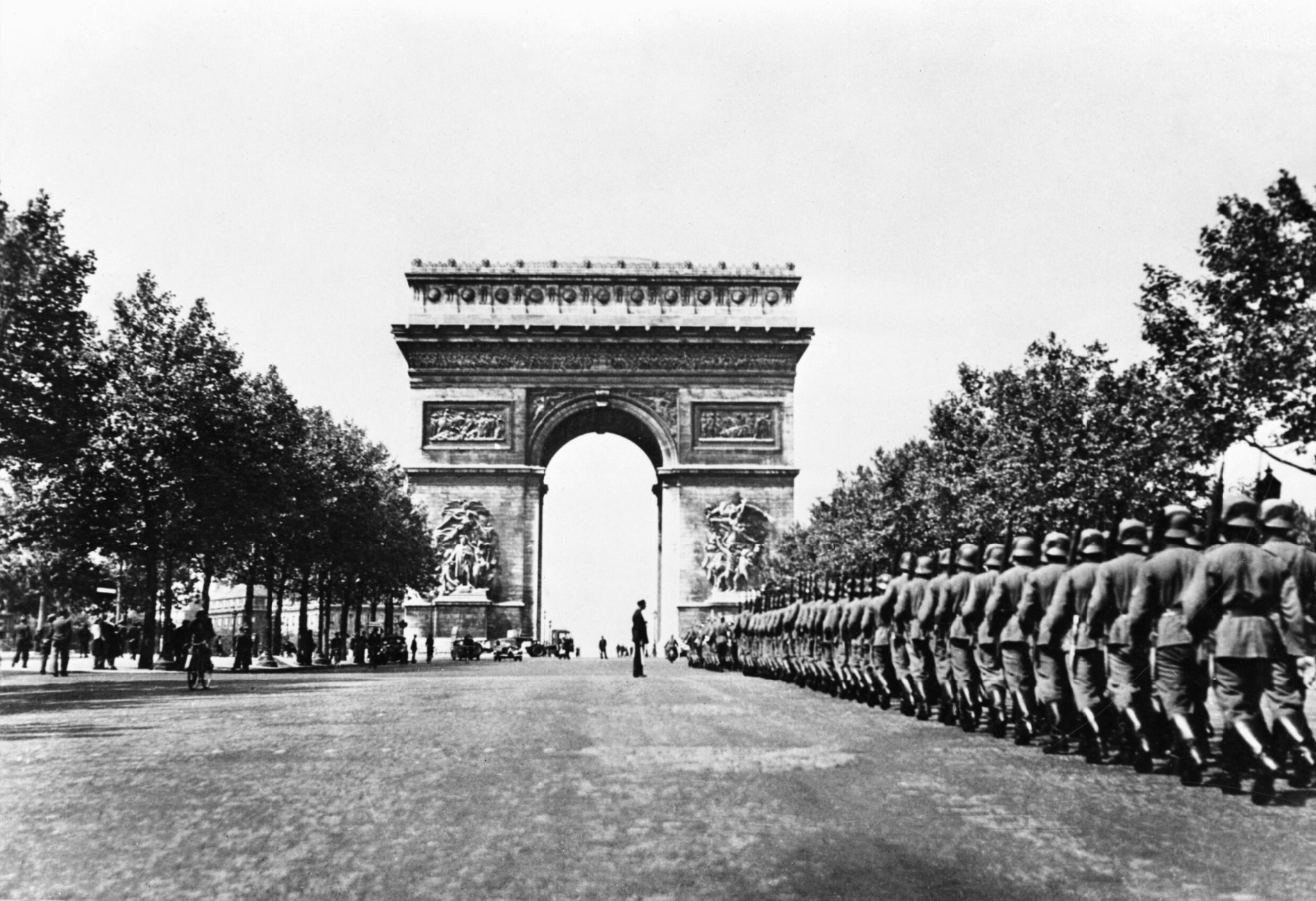
© IWM NYP 22535
Introduction
France, May 1940. The Germans cross the Ardennes forest and break through Sedan after eight months of “Phoney War.” Six weeks later, France signs an armistice and officially loses the war – at least for the time being. How did that happen? How could France, considered at the time a great military power, lose so quickly?
The Battle of France is one of the most dramatic defeat in modern military history. Yet, most people seem not to really know what caused it. This article seeks to provide answers to such questions by identifying the key elements (on the French side) which contributed to the defeat. The following analysis concludes that the French lost in 1940 mainly because of three reasons: intelligence failure, operational and tactical inferiority, and poor strategic leadership.
Intelligence Failure
Even before the campaign was fought, the French faced a disadvantage because of an utter intelligence failure. While the French had, at first, correctly guessed that Germany intended to attack mainly through Belgium, they completely failed to reassess German intentions over time and were eventually fooled by the enemy when they attacked through the Ardennes and Sedan. Consequently, the French forces were not adequately deployed to face the German onslaught. The irony of this French intelligence failure is that it began as a German intelligence failure. As noted, the French had initially guessed the overall German plan, and their thoughts were confirmed by the “Mechelen Incident.” On January 10th,1940 a German plane accidentally landed in Belgium. On this plane was an officer who held the Third Reich’s plans for the upcoming western offensives.1 At the time, the Germans planned to attack the southern Netherlands all the way to the coast, perform a two-pronged assault against Belgium, and possibly transfer armored and motorized units quickly in the direction of Sedan if the opportunity arose.2
If not for this incident (and bad weather), this plan would have been executed by Germany to attack Western Europe.3 Following this event, however, Hitler decided that a new plan was needed.4 It is only later, and because of the Mechelen Incident, that the known final version of Case Yellow was devised and executed.5 However, while the Mechelen Incident prompted the Germans to change their plans, it was the opposite for the French, and especially for General Maurice Gamelin, the commander-in-chief, who saw in this event the confirmation of his presumptions regarding Germany’s intentions. Indeed, he had correctly guessed that Belgium would be the main target.6 As a matter of fact, had the Germans attacked in January, the French forces would mostly have been at the right locations to counter the attackers.7
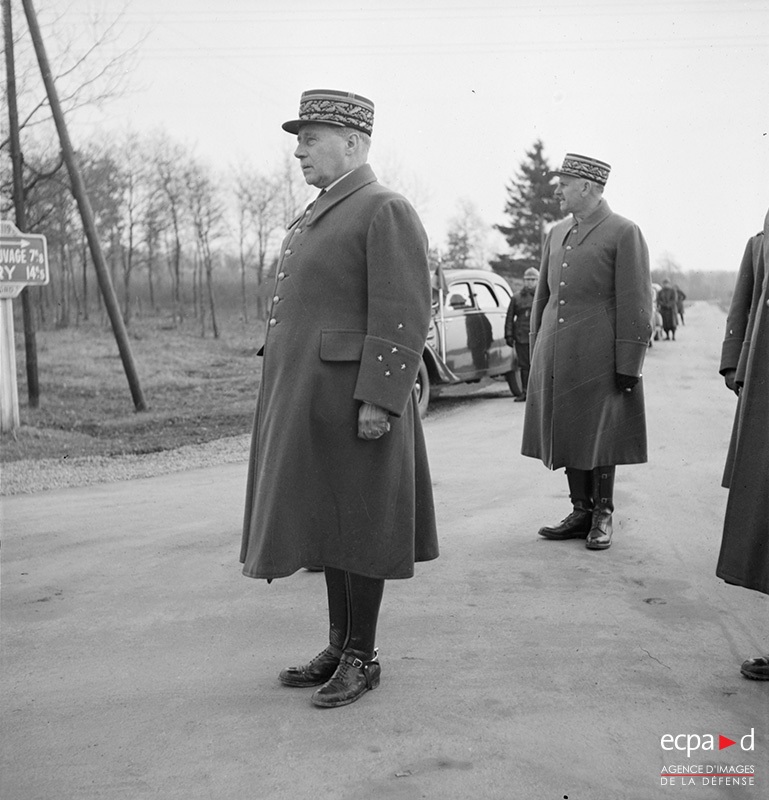
© Photographe SCA/ECPAD/Défense 9ARMEE-9-I228
Consequently, the French were eventually fooled by an unintentional counterintelligence action; Germany had accidentally given its plans to the Allies, but adapted and used this opportunity to fool the latter and eventually attack somewhere else.8 The French, however, never really considered that the captured documents could be deemed compromised by Germany, even if they had fallen into enemy hands.9
The French made a dramatic mistake when it comes to intelligence. Not only did they not regularly re-evaluate German intentions, they also failed to notice many pieces of information that indicated what Germany was planning after January 1940.10 For instance, many German reconnaissance planes were flying over the Ardennes area; a captured German pilot confessed that his mission was to reconnoiter the area around Sedan; there was an unusual amount of German “tourists” going to Luxembourg; French intelligence had learned that one of the Abwehr’s best operatives was tasked with surveying the area from Sedan to Amiens – which would turn out to be the location of the main thrust of the German offensive;11 and Enigma intercepts suggested a higher probability of an attack through the Ardennes.12
Major issues help to explain why French intelligence failed to identify the upcoming offensive’s axis of effort. Maybe the most important of them is that French intelligence officers were not actually analyzing collected intelligence. They did not put such information into perspective and correlate data. As Ernest R. May explains in his excellent book Strange Victory, French intelligence never “addressed the questions ‘Why?’ or ‘What is really going on?’”13 Rather, they left those questions to the strategic decision makers , who were expected to develop their own conclusions.14 No one had the task of assimilating intelligence and relating it to operational planning.15 Consequently, there were no French intelligence officers whose job was to think of what might be happening on the other side of the border among German forces.16 This particular issue proved dramatic; an attack through the Ardennes was actually considered by French intelligence, but, in their eyes, it ultimately remained as likely as an attack through the Maginot Line or Switzerland.17 French intelligence did collect many indications of the changes in the German plan, but failed to notice the red flags.18
Another issue was that all of the French intelligence officers were made from the same mold, which very likely reduced the chances of having diverse opinions and analyses, and there was no room for civilian experts to provide additional insight, notably when it came to the industrial, political, diplomatic, and economic aspects.19 Furthermore, the bureaucracy among French intelligence services prevented the circulation of new information which questioned the pre-accepted dogma.20
Moreover, the structure of the French intelligence services was not adapted to ensure a good flow of information towards the relevant decision makers. 21 For instance, there was no joint intelligence committee overseeing all the different intelligence services, such as in the United Kingdom. Instead, they were under the jurisdiction of different ministries (Foreign Affairs, War, Navy, and Air), without having an overarching entity coordinating their efforts other than the government itself.22 Consequently, there was no direct link between the key civilian decision makers and the intelligence officers.23 As an illustration, one head of the intelligence services, Colonel Louis Rivet, only met with Defense minister Edouard Daladier five times in three years.24
French intelligence failed to identify the Ardennes as the main German crossing point, in part because it failed to re-evaluate German intentions, correlate data, and ask questions. These mistakes led the French forces to be ill-deployed to face the attack, which proved absolutely dramatic: the best French troops fell for the trap, were in the wrong places and got cut-off, while the worst-prepared ones faced the best German troops.25
Operational and Tactical Inferiority
Doctrine
“Methodical Battle”
French doctrine played a huge part in the defeat, since many of the issues in the French army were directly or indirectly due to doctrine. It was not tailored for fast-paced warfare, it did not encourage officers to improvise, and it made the French extremely slow. Doctrine probably is the most critical factor in explaining French defeat.
Following France’s great loss of lives in the First World War – about 40% of the active male population – the French military rejected the idea of improvised, unprepared offensives.26 Indeed, they thought that a hasty attack against a well-prepared position was probably doomed for failure, and that the only way an attacker could succeed would be thanks to a greater concentration of fire with “three times as much infantry, six times the artillery, and fifteen times the ammunition.”27 The French also believed that evolution in firepower made centralized control much more important than ever.28 Consequently, the complexity of such an effort dramatically reduced maneuverability and required rigorous coordination.29 From then on, the battle would be “methodical” or “conducted.”30
As Robert A. Doughty explains, this doctrine envisioned “a tightly controlled battle in which all units and weapons were carefully marshaled and then employed in combat. The French preferred to have a step-by-step battle in which units obediently moved between phase lines and adhered to strictly scheduled timetables […] They preferred a time-consuming, intricate process that prized preparation rather than improvisation.“31
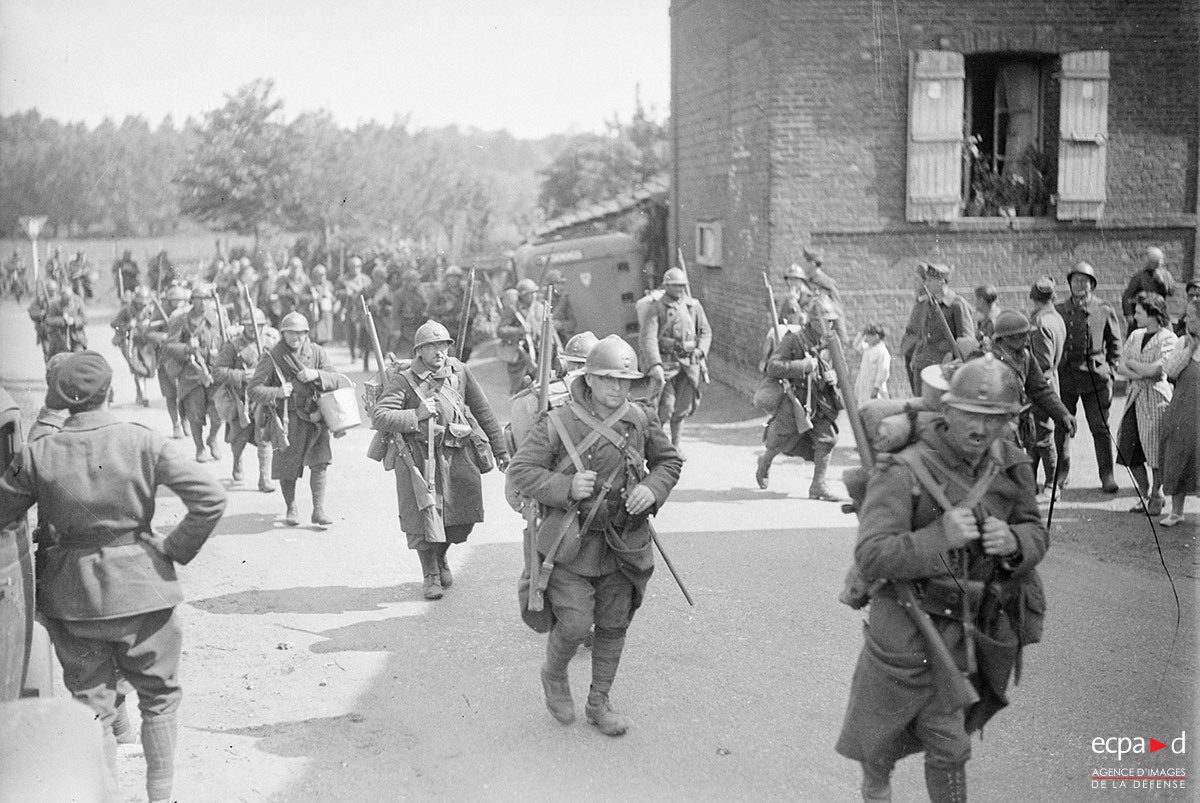
© Photographe SCA/ECPAD/Défense 7ARMEE-60-G458
Unit movement was also limited by artillery range; artillery fire acted as a protective umbrella under which every action had to be planned and performed, and beyond which nothing would happen.32 Counterattacks would typically rely on the use of firepower rather than maneuvering. But for such counterattacks to succeed, the French would need to move units in front of a penetration faster than an enemy attacker could advance.33
Because this doctrine required great coordination, the French believed that “the locus of decision-making had to remain at the higher level.”34 As a result, battlefield commanders had little flexibility or room for initiative – which was the complete opposite of German doctrine – and the entire system was designed to be very top-down.35 This meant that the French military establishment was unlikely to respond flexibly to unforeseen situations and could hardly capitalize upon gains made by lower-level units.36
A byproduct of French doctrine was slowness. Because it tried to remove as much friction as possible from the battlefield, “methodical battle” doctrine gave very specific requirements and instructions to conduct an assault, based on different factors such as width, depth, and timing.37 Procedures were heavy and formal and took a long time to put in place.38 There was a sort of “battlefield bureaucracy,” as Karl-Heinz Frieser calls it in his excellent book The Blitzkrieg Legend, under which all the staff were organized to methodically foresee all the operations on the ground. Consequently, this system relied on very lengthy, long-to-prepare orders containing a lot of details, which necessarily took a toll on the pace of operations.39 Slowness would also prove problematic because, as stated earlier, for French counterattacks to succeed, breaches would need to be plugged faster than the enemy would advance.40
Inflexible Command and Control
One of the main issues of French doctrine was its requirement of a very vertical command structure. As stated earlier, local battlefield commanders had very little flexibility. At the tactical level, officers were not trained nor used to improvise, and were not encouraged to develop initiative. The French believed that the higher-level leaders had to be in charge, since they were the only ones that had the required perspective to manage and coordinate all the different soldiers and materiel on the front. Consequently, under French doctrine, if officers at the operational and strategic levels were unable to devise sound solutions to respond to the German assaults, the French soldiers on the ground would likely be doomed.41
A critical issue was that in the kind of fast-paced warfare that the Germans imposed to the French, tactical leaders were key. Indeed, since the situation on the frontline was prone to very quick, if not constant changes, local battlefield commanders were the ones in the best position to assess what the enemy was doing, how they were doing it, and what were the immediate effects of their actions. They were the ones who could take the quickest decisions to adapt to the circumstances.
But since French doctrine favored a very top-down command structure, the operational and strategic leaders had to be very efficient to compensate for the lack of the tactical leaders’ flexibility – if that were even enough. Since French doctrine did not allow tactical leaders to be flexible, the outcome of the entire campaign relied heavily on the top French military leadership.
The problem was that at that time, there were seemingly very few senior and general officers who had the boldness to innovate, knew how to improvise, and had the personality of a leader, as will be later detailed.
Tanks as Tactical Infantry Support
Another doctrinal issue lied with the employment of tanks. In the French army, tanks were not part of an independent branch. Instead, they were subordinated to the infantry, and were first and foremost a means of supporting it.42 As a result, the French saved their tanks mostly to accomplish the infantry’s tactical objectives, and the latter was free to use them as it saw fit. Consequently, tanks were used piecemeal; since French armor was disseminated among infantry units, they were spread out throughout the frontline.43 For instance, at Stonne, the French used the 3rd Armored Division not as a single, big armored formation, but instead split it to reinforce several divisions of the 21st Corps.44
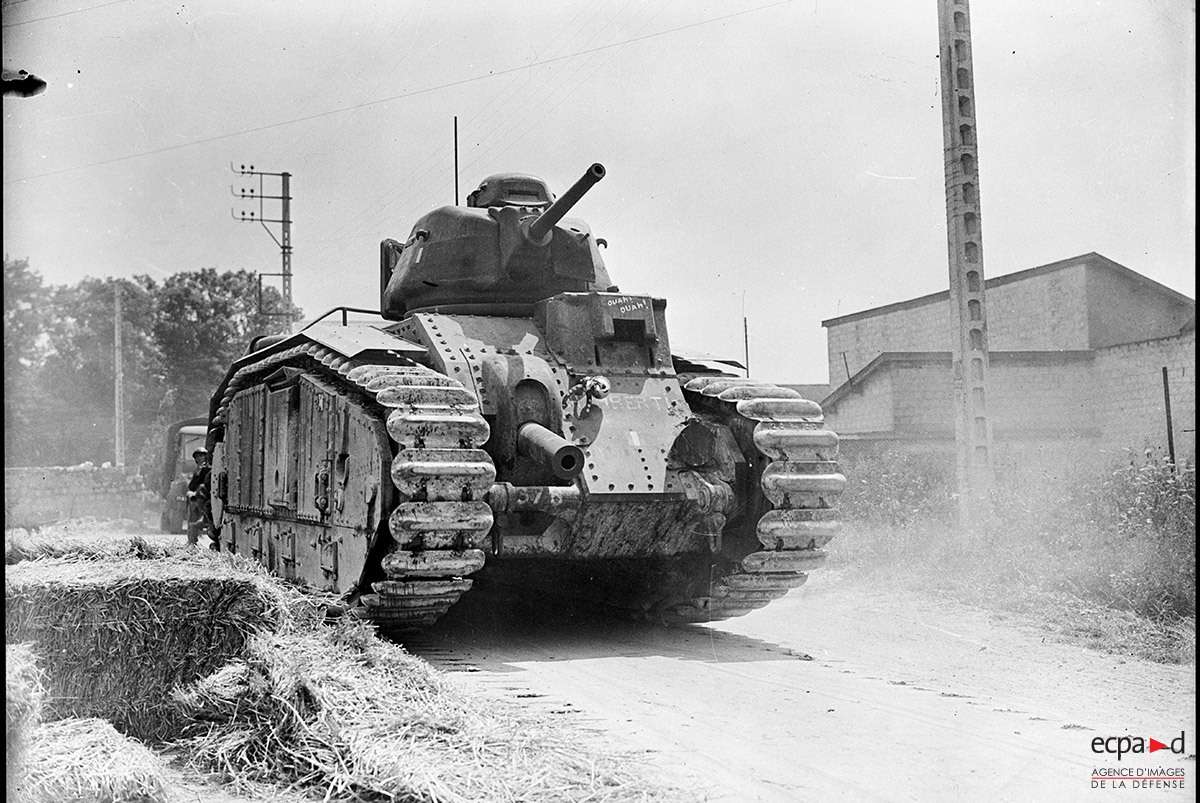
(May, Strange Victory, 478; Frieser, Le mythe, 350, 420)
© Photographe SCA/ECPAD/Défense DG 109-1418
Since each local commander wanted to use tanks for tactical objectives, tanks could not be used to accomplish wider, operational goals. Isolated, tactical actions did not allow for large armored maneuvers that might have had a chance of countering the Germans at the operational level.45 Furthermore, French officers and armored units were not trained to wage operational maneuvers with tanks. They only knew how to use them for tactical maneuvers, unlike the Germans.46 On top of these issues, there were, in the French army, no command principles, directives, trained staff, or adequate communication systems to perform operational counteroffensives.47 As a result, the French could not muster their armored units to meet the German offensive other than locally, and had a hard time trying to gather the previously disseminated tanks for a larger attack in one area.48 Without bold and innovative-enough leaders to compensate for all these issues, the French could not use tanks efficiently to stop the German onslaught.49
Poor Senior and General Leadership
The French military leadership was overall poor at the operational and tactical levels.50 Doctrine contributed to extremely poor leadership, but not only; for whatever reason, some of the French leaders “simply” made bad decisions and acted “objectively” poorly.
The seeds of bad leadership were seemingly planted in the interwar period, following the victory of the Great War. The French military school of Saint-Cyr did not encourage its students – the future officers of the French army – to think outside the box. They were instead encouraged to follow the prescribed doctrine without questioning it. French officer André Beaufre, for instance, who attended the school at this period, recollected that they were being taught a “narrow,” strict doctrine. According to him, tactics were simple and consisted of following a group of guidelines to the letter.51 As a matter of fact, before the campaign, the Germans had expected French commanders at every level not to act before receiving minute instructions that would be given only slowly.52 These elements are indicators which help to explain why French officers were simply unable to react to German assaults.
Particularly at the beginning of the campaign, the French senior and general military leadership was unable to efficiently react to the German onslaught. They misunderstood the type of warfare that was being waged against their forces, and the doctrine they were following did not encourage them to innovate. Consequently, the French military leadership repeatedly made mistakes – most notably in the first few weeks of the campaign – which hindered the ability of their forces to repel the Germans, and which served the German objectives. French officers very often reacted extremely slowly, not knowing how to quickly muster their forces to attack, were unable to adapt to changing circumstances, and showed poor individual leadership skills. Such poor leadership on the battlefield can be explained by doctrine, poor individual decision-making, or a mixture of both.
For instance, on May 13th, General Lafontaine, leading the 55th Infantry Division, was ordered at 2000 hours to counterattack. However, instead of doing so immediately, he asked for more detailed orders from corps command.53 As Karl-Heinz Frieser states,General Lafontaine had a mission, but he wanted an order.54 At 0100, five hours after he had received his mission, he went himself to corps command – which was to the opposite side of the frontline – from which he only came back at 0400 hours, eight hours after his superior officer, General Grandsard, had instructed him to counterattack.55 Only then did he start giving orders to his division. Even then, Lafontaine was still hesitant because he had not received a written order from corps command; General Grandsard had given the order over the phone.56 Finally, after 0500 hours, General Lafontaine finally gave the order to counterattack. Nine hours had been wasted.57
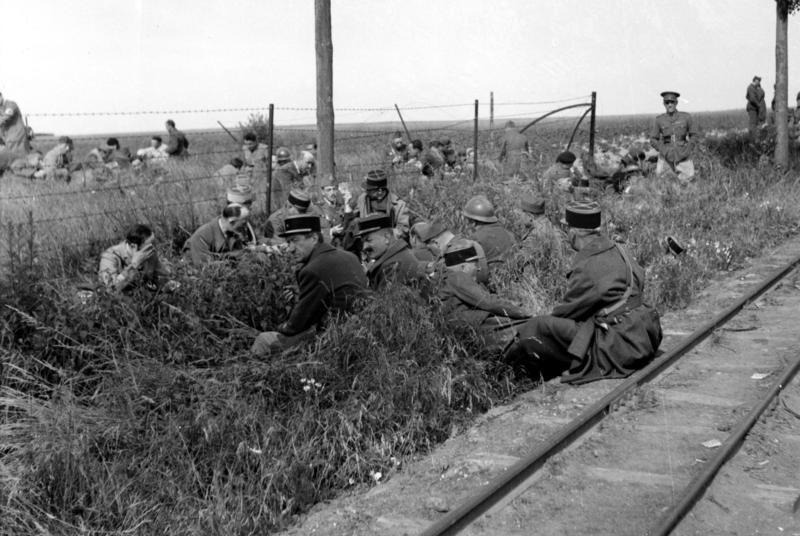
© Bundesarchiv, Bild 121-0447 / CC-BY-SA 3.0
In another instance, on May 14th, Lieutenant-Colonel Montvignier-Monnet, in charge of the 205th Infantry Regiment, wanted to contact his superiors to obtain a new order. Consequently, he left his unit behind as he personally went for it.58 However, as stated earlier, these two examples are not only bad leadership. Under French doctrine, every action had to be carefully planned and had to be performed only after a clear order was given.59
One critical issue was that the French leadership was unable to react other than tactically. The only occasion in the entire campaign where the French had a concrete opportunity to mount an operational counteroffensive on May 14th-15th was a complete failure. The French officers were simply unable to properly coordinate the attack. They threw in their units piecemeal.60 Even General Flavigny – considered to be one of the most apt officers to mount an offensive – despite curiously overseeing only two of the several divisions meant to attack, failed to properly coordinate the actions of his units.61 Doctrine surely was part of the reason why, but one can imagine that with more organized, dynamic, innovative, able-to-work-under-pressure, and bold senior and general officers, things might have been, at least in some situations, different.
Of course, French officers as individuals were not the only reason why their leadership was poor. As stated earlier, there were no command principles, directives, trained staff, or adequate radio equipment to perform operational counteroffensives. As Karl-Heinz Frieser states, there was no operational “intellectual infrastructure,” since there was no training in this regard.62 Even a great officer might have had a hard time performing very well under such circumstances. Still, senior and general French officers overall appeared not to try hard enough at times (although one must admit, it is easy to judge their actions sitting in a comfortable chair, 80 years later).
Lack of Effective Combined Arms
Another critical issue which helps to explain French tactical inferiority was the lack of effective combined arms. Too often, the French failed to efficiently integrate infantry, armor, and air power to conduct operations. Tanks tended to act with little to no coordination with the infantry, and air units were too rarely able to directly support ground units. There are reasons for such a lack of effective combined arms. The circumstances on the ground, the lack of adequate materiel, and the air military structure and doctrine, are some of the main reasons why it was so difficult for the French to wage efficient combined arms operations.
There are several examples where French tanks were unable to efficiently coordinate their effort with the infantry or the air force, unlike the German units.63 For instance, on May 14th at Chémery, the 3rd Tank Company, which had the mission of supporting the 213th Infantry Regiment, attacked without having received instructions from the latter.64 On May 15th at Flavion, the French faced a German assault combining tanks, artillery and air power, while they only had tanks.65 Between May 15th-17th at Stonne, the French armor repeatedly repelled the Germans and even caused panic among them, but their attacks were ill-coordinated with the infantry.66 As a result, the French actions at Stonne ultimately were little more than isolated actions whose success could not properly be exploited.67 On May 17th at Montcornet, a bold offensive led by then-Colonel De Gaulle showed some initial success, but was stopped notably by the Luftwaffe, while the French had no air cover.68 As a matter of fact, De Gaulle had not even attempted to contact the French air force to support his offensive.69
One notable issue was communications; almost all the light tanks had no radio since they were meant to move with the infantry, so they used flags instead. Heavy and medium tanks had radio equipment which came too late, was incomplete, and sometimes inadequate.70 Consequently, French tank radios were often dead, which led to incoherence and disconnect between tank leaders and their subordinate units, unlike German tank units.71 Combined with other factors such as various local circumstances or fuel-related issues, tanks tended not to offer effective combined arms integration.72
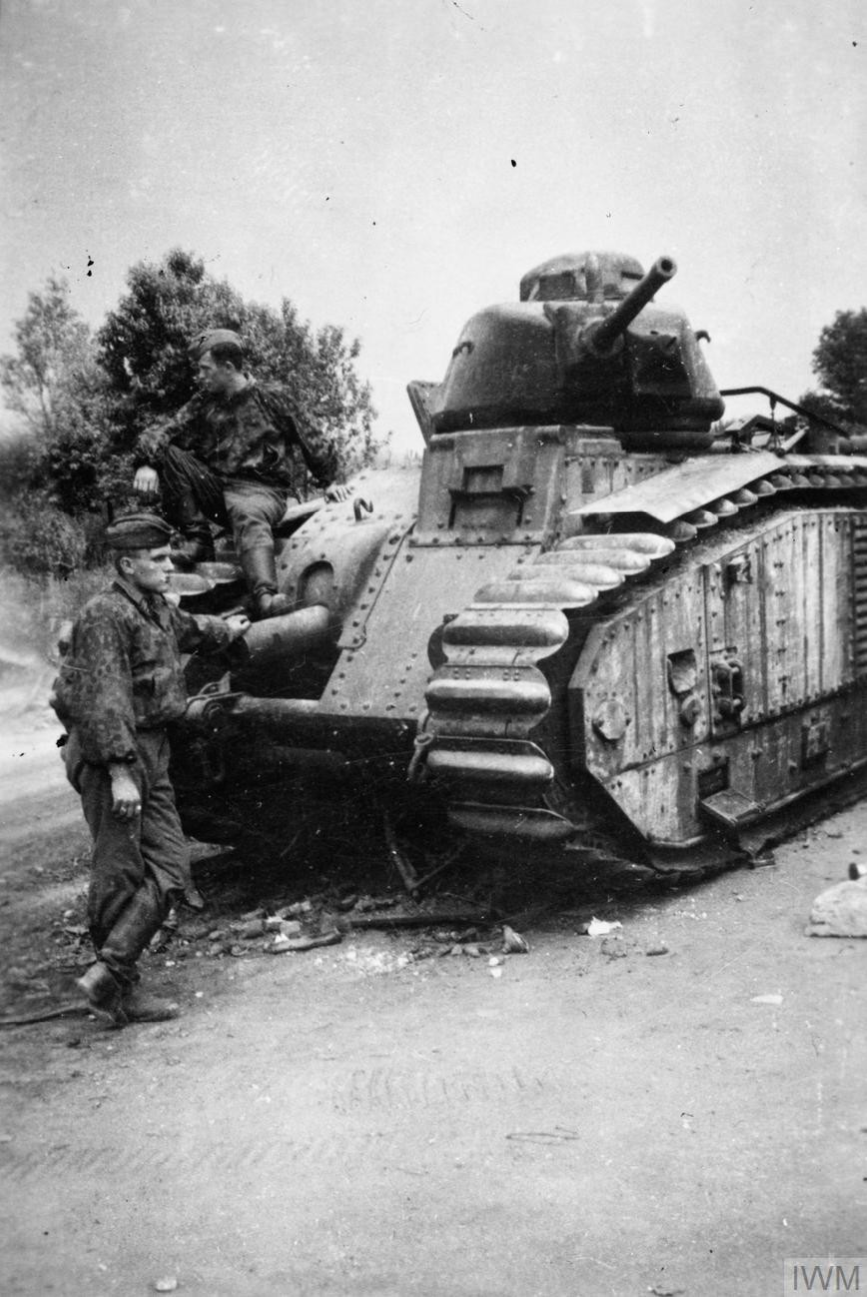
© IWM HU 38429
Regarding air power, there are several reasons why it failed to provide strong support to ground units. First, a doctrinal reason. Close air support was not the French air force’s priority in 1940. During the interwar period, the air force had sought autonomy and had rejected the concept of close air support in favor of air superiority and strategic bombing.73 Air officers, therefore, tended “by nature” to be reluctant to provide close air support.74 Furthermore, when it came to air superiority, the French air force was not so much focusing on winning it, but rather on contesting it.75 Finally, the French had envisioned a war in which saving their forces for the long-term would pay off. As a result, they were reluctant to send the bulk of the air force “early.”76
Second, the “air military structure” was inadequate to efficiently counter the German attacks. There was a heavy bureaucracy which prevented quick air reactions, and sorties were not centralized.77 About 40% of the French fighter force was split among several armies, which prevented France from using its airplanes in an efficiently concentrated fashion.78
Third, the French air force was simply too weak to efficiently face the Luftwaffe. The vast majority of the air fleet was obsolete, and France lost over 40% of its fighter pilots in the first half of the campaign.79 France simply did not have enough trained pilots to fly its aircrafts.80
According to John Buckley, the French air force’s “reactive stance and its notion of parceling air units out in small quantities to provide localized air cover across the front was untenable in the face of the Luftwaffe’s concentrated approach.”81 Combined with the other above-mentioned issues, the French air force was unable to support units on the ground to efficiently repel and push back the Germans.
The French did conduct combined arms. The issue was that in addition to German tactical skill, one or several elements were always or almost always absent or lacking for them to be efficient. For instance, proper coordination or air support were too often missing. Perhaps the best French combined arms action in the entire campaign was the one conducted by General Charles de Gaulle on May 28th-30th at Abbeville. But even this action, despite achieving some success, eventually failed.82
Poor Communications
One issue among the French forces was communications: the French were very reluctant to use radios, which made them even slower. As a matter of fact, the Germans had assessed before the campaign that the French would be slow in part because they emphasized communications security, which meant that they had few radios or other means of receiving urgent orders.83 They were right: to prevent communications intercepts, the French privileged the phone, along with telegrams and couriers.84 Because of this and the above-mentioned doctrinal elements and their byproducts, the French reaction time was dreadfully slow. When an important order reached the units concerned, it was often already too late.85 Units on the move could seldom be contacted, and on average – at least during the first eight/nine days of the campaign, when General Gamelin was commander-in-chief – about 48 hours were spent before an order arrived from the Grand quartier général (the French top headquarters) to the frontline units concerned.86
The situation of the 9th Army is a good example of the consequences of the French “communications doctrine.” On May 12th before midnight, German and French troops exchanged fire to the left flank of the 11th Corps. Yet, it took its commander, General Martin, several hours to be aware of this: he knew about it only at 0500 hours. General Corap, the leader of the 9th Army, was aware of this engagement only at 1200 hours, and the French high command was informed at 1330 hours that the Germans had crossed the Meuse river.87 On May 13th, General Doumenc, leading the 18th Infantry Division, reported that the liaison between the divisional and regimental command posts were difficult: phone lines had been cut, the radio was not functioning, and there were no motorcycles to send couriers.88
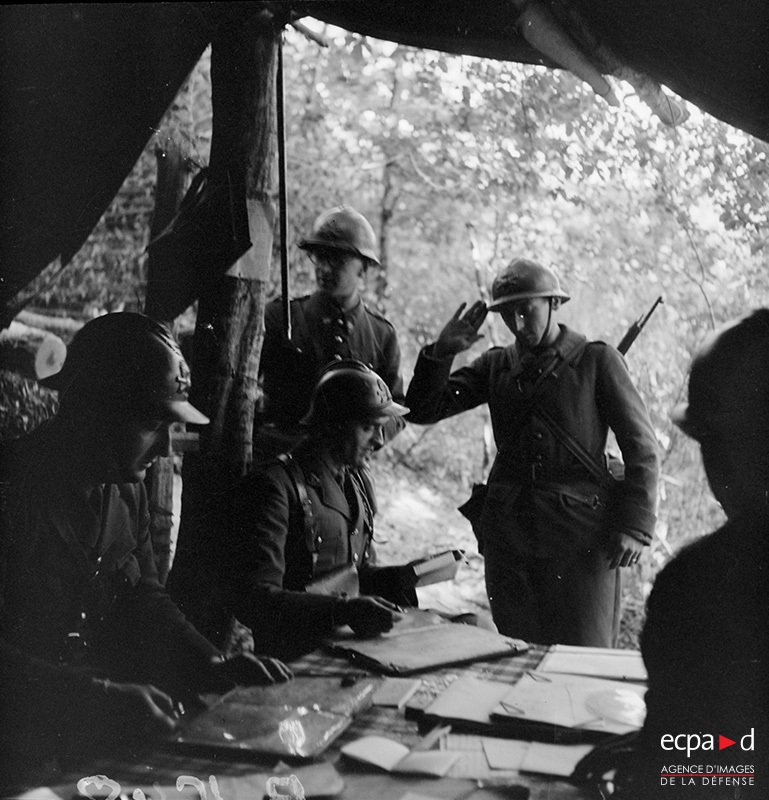
© Photographe SCA/ECPAD/Défense 2ARMEE 117-B1648
Reports from 9th Army’s units reached General Corap way too late. By the time the information went all the way up to him, the situation on the ground had already changed.89 As a result of such a confusion, Corap actually went himself from division to division, trying to find out what was going on.90 Consequently, when his superior officers Generals Gamelin and Georges (commander of northeast theater) tried to contact him, or when a local French commander “became desperate enough” to use a radio to get reinforcements from 9th Army’s headquarters after having spotted a “mile-long column of tanks,” they had received no answer. Corap and his staff were in the field, trying to see for themselves what was going on and whether the whole army group line had been breached.91 This situation was most likely similar in many different units, given the quick German advance and the dramatically slow reaction of the French overall.
Finally, privileging the phone over the radio meant that communications could be critically fragile since they were concentrated in one spot. For example, when the Germans reached Abbeville on May 20th, where the phone centers were located, they cut the lines, preventing phone calls and telegrams between the Grand quartier général and the armies in northern France.92
Consequences on the Ground
All these intertwined issues – inadequate doctrine and all its byproducts, poor operational and tactical leadership, lack of effective combined arms, and poor communication systems – resulted in dramatic operational and tactical inferiority. Because of these issues – especially doctrine – the French forces were unable to improvise, quickly react to changing circumstances, had no clue how to quickly organize large counterattacks involving more than a few units, and were dreadfully slow. Such issues were critical in the kind of fast-paced warfare that Germany imposed on France in 1940. As a matter of fact, the Germans had, before the campaign, rightly identified slowness as a byproduct of French doctrine. Indeed, they had anticipated that the French had a naturally slow action or response rate.93
The French simply could never stop the Germans with lasting effects. The best the French could do was to temporarily stop the attackers at the tactical level. Beyond this level, the French were unable to do anything. The only actual attempt at an operational counterattack in the entire campaign ended up an utter failure. On the defensive, the French could hold off the enemy for some time, but with a doctrine that did not favor improvisation and a leadership unable to muster their forces and innovate to counter the Germans, it was only a matter of time before the latter found tactical solutions to overcome even the best French defenses.
Many examples illustrate French operational and tactical inferiority.94
On May 13th, Colonel Dugenet, leading the 39th Infantry Regiment, had been ordered to counterattack for 2000 hours. Yet, he asked for a delay and the attack was pushed back by an hour. However, at 2045 hours, the colonel informed that his infantry was still not ready. As a result, his tanks moved in, unsupported by the infantry, but night fell, so the French attackers fell back.95
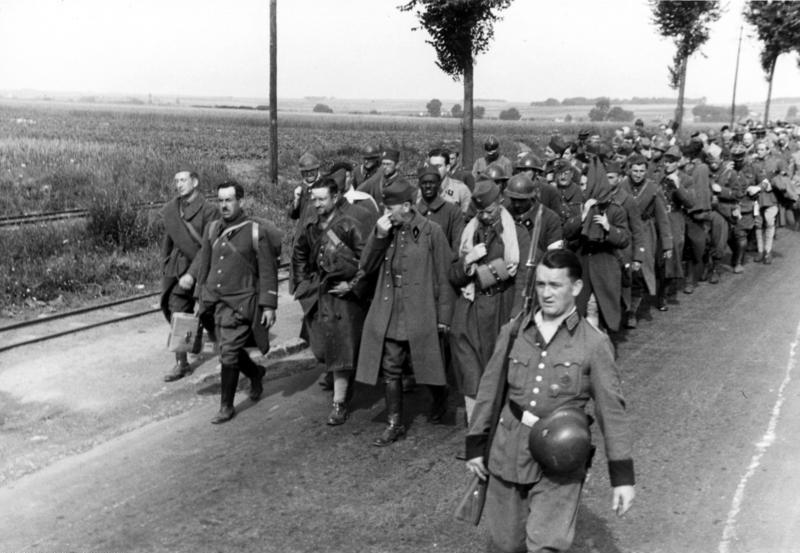
© Bundesarchiv, Bild 121-0404 / CC-BY-SA 3.0
On the same day, the commander of the 5th Motorized Infantry Division, General Boucher, knew since 0200 hours that the Germans were by his unit’s right flank. Yet, he only acted around 0730 hours – five hours and a half later – to send reconnaissance elements. Then, he ordered a counterattack at 1100 hours – nine hours after knowing the Germans were in the area. It was meant to take place at 1400 hours, but was delayed to 1500 hours. The unit then finally moved up, but German planes attacked them and were repelled. That was the end of this action which had taken many hours to decide, plan, and perform – for no result.96
Later, the same unit planned a counterattack, meant to take place at 2015 hours. But because the infantry was late, the counterattack was pushed back by 45 minutes, and then by another hour. When night fell, another delay occurred since it was decided to move the attack to the next morning – which would be too late since the Germans would, unlike the French, not wait for daylight to act. They would cross the Meuse river overnight, and would break through the next day.97
These two events are very interesting because they involve two different units under the leadership of two different officers – one general and one senior – and part of two different army corps – respectively 2nd Corps and 11th Corps.98 Despite all these differences, when these two units faced the same issues – unprepared infantry and nightfall – they reacted the same way – by delaying the offensive and eventually canceling it. Neither the general nor the colonel could find ways of improvising to overcome the obstacles they faced. It gives a strong indication that all previously described issues were not limited to a small number of units, but was widespread.
In another instance, on May 14th, General Lafontaine was unable to occupy some key terrain in Bulson before the Germans, in part because his tanks were advancing at the pace of the infantry – as advised by “methodical battle” doctrine.99 On the other hand, German tanks often swore by speed and moved as fast as possible.100
The same day, General Flavigny received an order to counterattack after 0500 hours. He then ordered a division commander to prepare his unit to perform the assault. The latter gave the order to his officers between 0800-0900 hours, and all his units received the order only between 1100-1300 hours. The units were ready only at 1730 hours. It had taken about 10 hours to prepare for a counterattack.101 The next day, Flavigny received an order to counterattack at 0830 hours while it had been initially ordered at 0715 hours.Onlyat 1000 hours, Flavigny gave the order to his officers to conduct the offensive at 1400 hours. However, because his tanks had been dispersed among multiple units, because most radios were dead (they had not been charged), and because the French had failed to retake for good the hamlet of Stonne (deemed necessary to perform the counteroffensive), the move was delayed to 1600 hours and then to 1830 hours, to finally be canceled at 1815 hours.102
These events illustrate the dramatic impact of all previously described issues – notably doctrine and poor leadership – on the tactical and operational efficiency of the French forces. The contrast with German forces at the time is absolutely striking. As an illustration, between May 13th-14th, French General Lafontaine took a total of 11 and a half hours to prepare his units to attack, while his German counterpart, General Kirchner, had needed 10 minutes.103
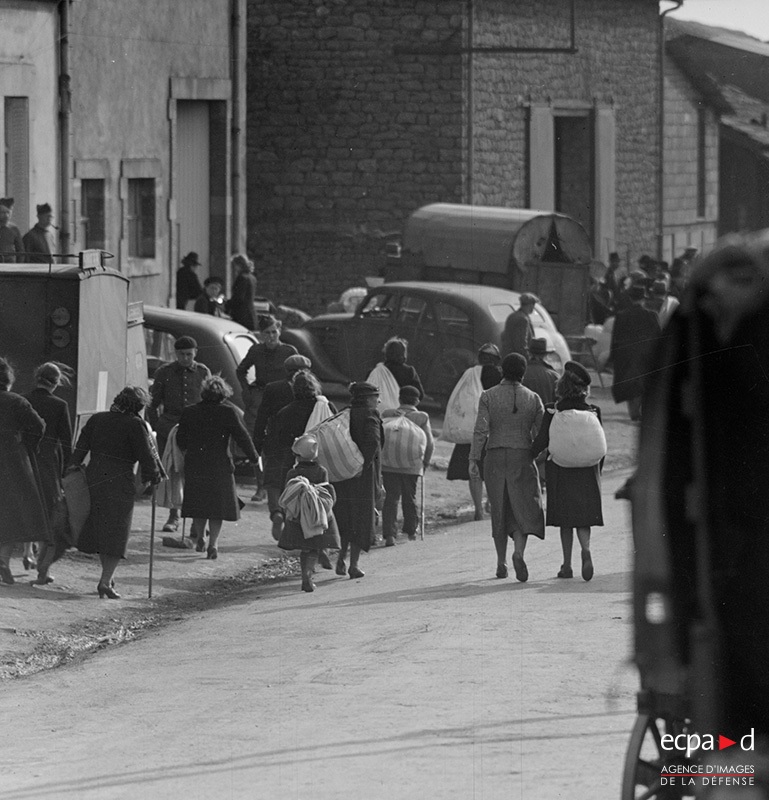
© Photographe SCA/ECPAD/Défense DG 115-1546
These events showcase examples which took place at the very beginning of the campaign, but the French did not perform much better later on. Under General Weygand, the French tried a different approach in Fall Rot (the second part of the German invasion) on June 5th onwards by using “hedgehog” or “quadrillage” tactics. The idea was to establish multiple neighboring strong points facing all directions in order to channel the German formations and force them to use specific itineraries.104 For the first 48 hours, the results were promising: the Germans gained little ground while suffering many casualties, including almost 3,000 on the first day.105 However, the French did not have enough units left to prevent the Germans from bypassing the strong points, nor did they have enough units to establish defensive positions sufficiently in depth for the “hedgehog tactics” to be optimal.106
By this point, France had already lost too many units for such a plan to work; in the first three weeks of the campaign, 30 divisions had been lost or seriously diminished: 24 in 67 infantry divisions, two in five light cavalry divisions, all three light mechanical divisions, and one in four armored divisions – a total of 30 divisions, which included some of the most modern and best equipped units in the French army.107 Consequently, while the French probably fared better in Fall Rot than in Fall Gelb (the first part of the German invasion), the first half of the campaign had taken a strong toll on the French forces, and seriously hindered their ability to stop the Germans at the strategic and operational levels in June – at least under Weygand’s plan.108 Operational and tactical inferiority – bred by inadequate doctrine, poor operational and tactical leadership, terrible communications, and lack of effective combined arms integration – was a critical reason for such a loss.
Poor Strategic Leadership
The French strategic leadership in 1940 was bad to terrible. The two commanders-in-chief of the campaign, Generals Maurice Gamelin and Maxime Weygand, along with the civilian leadership – especially Philippe Pétain – behaved in a way that greatly impaired France’s ability to successfully fight the war against Germany.
Military Leadership
One mistake Gamelin made was to sacrifice a significant portion of the French strategic reserve – the 7th Army, which contained some of France’s best and most mobile troops – thus impeding the French from responding to an unexpected German move in case of operational surprise.109 Gamelin had seemingly good reasons to do so.110 However, he made a terrible mistake by ignoring a basic military principle: always keeping enough reserves to cope with an unforeseen event.111 Such a dramatic mistake meant that the French would not have many reserve units to face the unexpected German thrust through the Ardennes.
Further, Gamelin apparently failed to use intelligence to support the French plan to plunge into Belgium. While the validity of such a plan had seemingly been confirmed by the Mechelen Incident in January 1940, there is no evidence that he made any apparent effort to reassess his plan with the support of post-January intelligence elements. There is no sign that Gamelin based his plan on sound intelligence analysis, or that he even met with the top intelligence officers for counsel.112 The mere fact that he apparently did not seek to extensively use intelligence to support his plan is a grave mistake for the commander-in-chief of any army.
Moreover, Gamelin showed a critical lack of energy. Instead of quickly giving orders left and right to change the situation after the breakthrough at Sedan, reinvigorate his officers and heighten morale – in other words, do what would be expected of the commander-in-chief of any army – he acted with little energy to reverse the critical situation France was in.113
Another testimony to bad strategic military leadership was Gamelin’s replacement, General Maxime Weygand. Weygand replaced his predecessor on May 19th, after the latter was sacked.114 If Maurice Gamelin’s faults were imprudence and lack of energy, Maxime Weygand’s was defeatism. As soon as May 25th, less than a week after his nomination, he showcased pessimism which could have been interpreted by some as defeatism.115 After the beginning of Fall Rot and the Germans crossed the Somme river in force, he began to openly speak in a defeatist tone.116
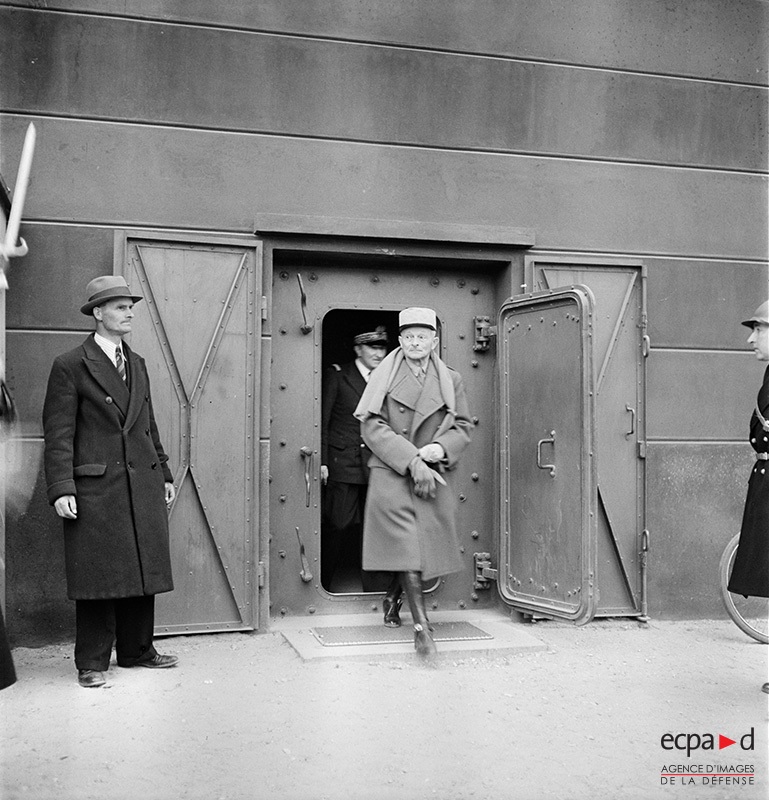
© Photographe SCA/ECPAD/Défense Marine 279-3856
However, when things seriously started looking bad for France, he could have at least attempted to pursue the fight from North Africa and from the other French colonies. Yet, Weygand mocked the idea of retreating to North Africa, and considered the option unrealistic.117 The issue is that he seemingly never even seriously considered such a possibility. He even claimed that it was impossible since there were “no ships” to transfer troops there, which was completely wrong.118 Not only was the French Navy almost intact, but also Winston Churchill himself had offered any British ship necessary to transport French soldiers and materiel there.119 Weygand seemingly made no serious analysis regarding the North African option. Instead, he seemed to be motivated by emotion and intuition; he qualified the French colonies as “childishness,” and in his assessment – obviously without any tangible elements to back it up – the United Kingdom would sue for peace within “eight days” after France gives up fighting.120 He flat out expressed his refusal to pursue the fight outside continental France, excluding any attempt to do so.121 Such a behavior was completely out of place for the commander-in-chief of a democracy’s military.
Moreover, he agitated the spectrum of disorder and chaos to convince the other decision makers to rally his opinion. In a cabinet meeting, Weygand claimed that a communist insurrection had broken out in Paris, and that an armistice should be requested to control civil disorder. Following this claim, the minister of the Interior, Georges Mandel, phoned the Paris police chief, who indicated that all was quiet.122 It is unclear if Weygand genuinely believed his own claim, or if he was willfully lying about it to get his way. Either way, even in good faith, the commander-in-chief of a democracy’s military should not try to influence the civilian leadership and decision-making process by agitating the spectrum of insurrection if it is not based on a sound and realistic analysis – which was obviously not the case there.
It can be said of Weygand that he crossed the line and did not respect his role of commander-in-chief in a democracy. Instead of sticking to managing military operations, leading his troops, and giving unbiased military advice to the civilian leadership, he overstepped his boundaries to ensure his opinion would prevail, quickly became defeatist although he had seemingly not even seriously considered an evacuation to the French colonies, and took sides without offering objective military advice to support the civilian decision-making process. In times of dire need, France needed an optimistic military leader who would genuinely attempt everything to turn things around – which in this specific situation could have even meant just continuing the fight another day from elsewhere. Instead, France got a pessimistic leader who thought that his opinion was the only one which was right.
Civilian Leadership
The French strategic civilian leadership also had flaws which impaired France’s ability to win the war in 1940.
The French President of the Council (the Premier), Paul Reynaud, was not decisive enough and failed to emerge as a strong figure who could give a clear direction to France in such critical times. He would have liked to keep fighting from Brittany or North Africa, but he was never able to quiet down the opponents to such ideas, most notably Philippe Pétain and General Weygand.123 He did not impose his will to others, and was too hesitant regarding the decision to pursue the fight or not.124 He was no Winston Churchill, who probably was the type of strong-willed figure France most needed at the time.
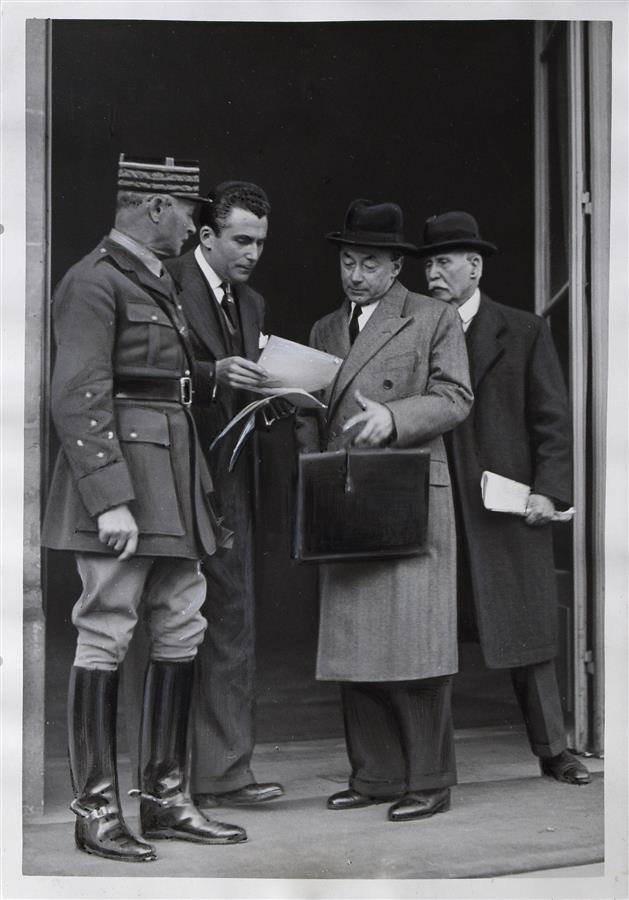
(Gallica, Wikimedia)
While Reynaud suffered from a lack of strong will and indecisiveness, his successor, Philippe Pétain, just like Weygand, was a clear defeatist. He was first called into government on May 18th by Paul Reynaud to serve as Vice-President of the Council (Vice-Premier).125 However, Pétain willfully undermined the efforts of those who wanted to keep fighting in North Africa, advocating instead for an armistice.126 Behind the Premier’s back, Pétain discussed the possibilities of a post-occupation regime with other ministers, and even started promising future positions in a later government.127
Pétain became the Premier on June 16th, following Reynaud’s resignation.128 The next day, on the radio, he openly asked for an armistice. However, it was a dramatic mistake because the French government did not know how its German counterpart would react to this offer: no serious negotiations had been initiated. Further, the announcement was vague and did not clarify whether the French soldiers should stop fighting now or later, or if the project of an armistice was a decision or a suggestion.129 Either way, the French head of government had publicly announced to all French soldiers and citizens, and indirectly to Hitler and the German military, that France was unlikely to hold much longer – before even engaging in serious talks with the German leadership. As a result, while the French units were supposed to keep resisting the German assaults, their morale naturally took a hit, even among the units which had remained coherent thus far, whose fighting ability “notably diminished.”130
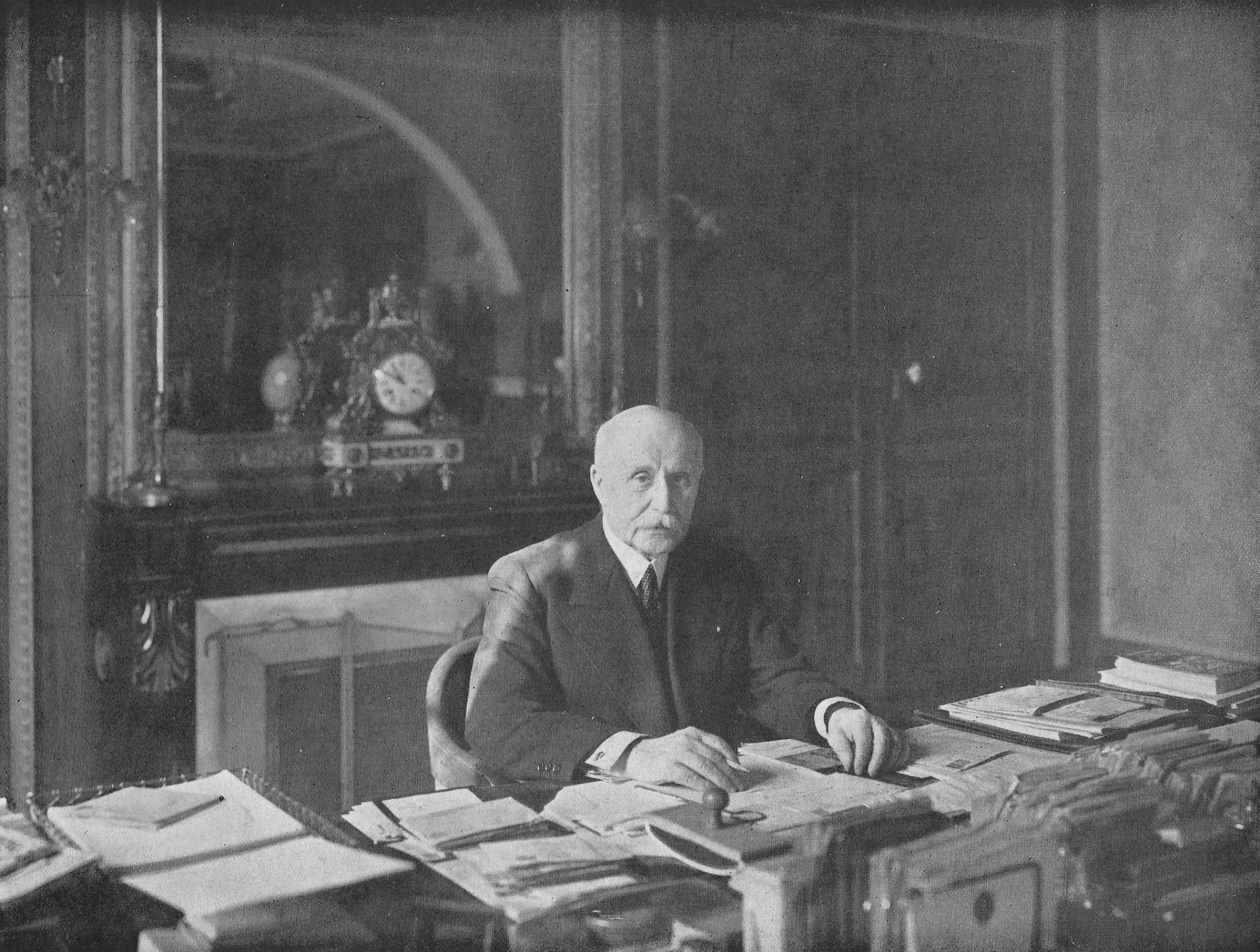
(Wikimedia)
Consequently, upon Pétain’s nomination as Premier, France’s very top leadership, both civilian and military, was composed of two defeatists. It is hard to imagine how any country could pursue a war when both the head of government and the commander-in-chief refuse to do so. At the time, the idea of an armistice likely appeared as a reasonable option to many. It would be too easy to criticize such an idea 80 years later, knowing the ultimate outcome of the Second World War, and who won and who lost. The issue is not the idea of an armistice per se, but that France’s leaders took the decision to give up way too quickly, that they did not actively try to pursue the fight another day and from somewhere else when it was a possible option, and failed to objectively assess all their options before declaring that all was lost.131
Debunking a Myth: A Lack of French Bravery?
One of the most die-hard myths about the Fall of France concerns French bravery. As a matter of fact, the Battle of France features many examples of French military gallantry.
Upon the declaration of war, French commander-in-chief General Gamelin was glad, and there were signs that the French population was confident.132 Upon mobilization, soldiers overall were not happy about the war, but they accepted the task ahead with resolve, sometimes even with a good mood.133
On May 14th, the morale of several French units was described as “magnificent” and “splendid.” They were anxious to see their first fight, and their officers were encouraging them.134 The French could also be very tenacious. For instance, between May 15th-17th, the hamlet of Stonne saw some very heavy fighting: it was taken back-and-forth by the French and the Germans seventeen times.135
An excellent illustration of French bravery was the superb and valiant defense of the Dunkirk perimeter during Operation Dynamo.136
For instance, in Lille, the French resisted for three days between May 28th-31st through heavy fighting despite being surrounded by seven enemy divisions. The defenders only surrendered after they were out of ammunition, and their remarkable resistance was acknowledged by the Germans themselves, who allowed the defenders the honors of war. The French marched out of the city in formation, carrying their weapons.137
While facing an overwhelming force, French forces conducted pre-emptive assaults to spoil the German initiative. On June 2nd, the French launched a vigorous counterattack and recaptured an area east of Hoymille which was previously occupied by the Germans. Attacking with 550 men and supported by two reconnaissance groups and six Somua S35 tanks, only 65 survived unharmed and withdrew, unable to hold the ground regained. A counterattack made by the French 150th Infantry Regiment even netted 60 prisoners.138
On June 1st-2nd in the Dunkirk area, the French, and in particular the 68th Infantry Division, repulsed several large German assaults. The soldiers’ morale did not collapse despite the critical situation which they were facing.139
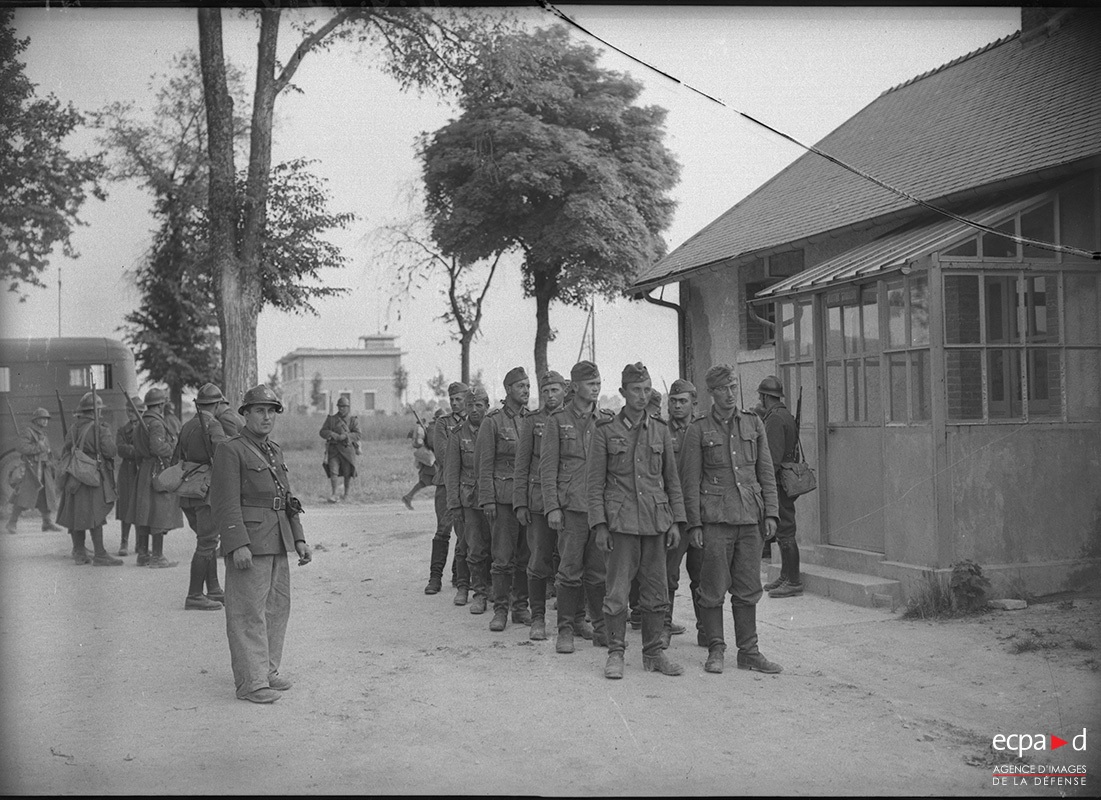
© Photographe SCA/ECPAD/Défense DG-128-1810
In other instances on June 5th, the first day of Fall Rot, several French positions were surrounded and fought on until they ran out of ammunition.140 There are several instances where the French forces – including soldiers from the French colonies – only surrendered after they exhausted their ammunition.141
Between June 14th-25th, on the Alpine front against Italian troops, while the French defenders were outnumbered (with ratios ranging from 1:3 to 1:10 depending on the sector), the attackers suffered over 6,000 casualties, against 274 for the defenders. “Awful weather” helped and frostbite was responsible for a big chunk of the Italian casualties, but regardless, French defenses on the Alps were very strong.142 Indeed, in addition to individual skill, the French benefitted from a solid network of fortifications and good artillery support, along with good morale.143
For example, in one instance, about 200 fortress troops repulsed an infantry division.144 In some areas, only a dozen of French soldiers repelled Italian battalions.145 Most remarkably, in a very peculiar skirmish at the Saint-Louis bridge, by the French city of Menton, only nine French soldiers fended off Italian infantry division Cosseria. They stopped fighting on June 25th – the day the armistice went in force – only after French officers went there to personally inform them the war was over. The same thing also happened in some sectors of the Maginot Line.146
The end of the campaign witnessed some of the most violent fighting; the French kept battling the Germans, despite the French government’s public demand for an armistice.147 In eastern France, some defenders kept fighting despite the fact that two of their generals ordered them to capitulate.148
In battle, frontline junior officers and non-commissioned officers often fought with “valor and determination.”149 Even senior and general officers could show courage. For instance, Colonel Cazeilles, commanding the 21st Colonial Infantry Regiment, personally led a charge against the enemy with his fellow officers and routed them. But two kilometers on, all of the officers were either killed or wounded. Trapped against the Germans, Colonel Cazeilles refused to surrender despite their offer, grabbed a light machine gun from one of his gravely wounded men, and fought until he was fatally hit.150 General Deslaurens, commanding the 60th Infantry Division, was killed while conducting a rearguard action to allow some of his troops to evacuate, personally operating his unit’s last functioning light machine gun.151
These many examples – which are not the only instances of French bravery and determination in 1940 – illustrate that French soldiers overall were very far from being cowards or easy-to-surrender.152 The French military leadership was unable to devise effective solutions to counter the Germans at the operational and strategic levels, and the French strategic leadership – both civilian and military – ended up being made of defeatists who were too keen and quick to surrender. However, French soldiers and frontline officers on the ground could have hardly done any better. They overall did what was asked of them, and performed as best as they could, given the critical circumstances they were facing.
Conclusion
France was not defeated due to military cowardice, nor did its soldiers lack the guts to resist their attackers, and certainly did not prefer to give up rather than fight another war. Not considering the factors on the German side, France mainly lost because of three, intertwined reasons: an intelligence failure, operational and tactical inferiority, and poor strategic leadership.
These three main factors are the most important ones when determining why France lost. They are decisive because if one of these factors is changed and all its related issues are corrected, France’s chances of at least resisting longer could have dramatically improved. For instance, if the French had correctly guessed that the main German thrust would be through the Ardennes forest, they likely would not have rushed their best units into Belgium, and might have been able to progressively slow down the Germans, avoid massive encirclement, and resist longer. Similarly, if the French had a different doctrine and were not that operationally and tactically inferior to the Germans, maybe they could have managed to better resist the enemy even after plunging into Belgium and being encircled in northern France, and performed efficient operational counterattacks. Finally, if the French had a better strategic leadership made of strong, optimistic, decisive, and energetic figures, perhaps a united French government and all the French armed forces would have been able to continue the fight from the colonies despite losing the metropolitan territory.
On the other hand, other factors, such as some units’ poor training, would unlikely have had a dramatic impact on the campaign if corrected. For instance, better training for reservists would probably have improved some of the units’ chances of holding their ground or inflicting more casualties. But in the campaign, even the best French troops were unable to decisively overcome the Germans in the long term. Given the overall situation, the best they could do was temporarily repelling the attackers and occasionally conducting local counteroffensives. Consequently, both more and better training would likely not impact the course of the war. Similarly, French airpower is a secondary factor because even with better planes, more trained pilots, and better air doctrine, it is unlikely that it would compensate for the impact of the three main factors (intelligence failure, operational and tactical inferiority, and poor strategic leadership), which would still have resulted in France’s demise.
Studying why a prime military power lost so quickly, especially against an enemy who very seriously doubted its prospects of success, should bring insight, questions, and possible answers to civilian and military decision makers alike.153 Military power is not only measured by the number of soldiers, tanks, and aircrafts, nor by pure firepower. If only these elements mattered, France could have won in 1940.
The author would like to extend his sincere gratitude to Raquel Orejuela and Erick Plascencia, who kindly reviewed this article.
For more pictures of the Battle of France from the French side, visit https://www.ecpad.fr/actualites/la-bataille-de-france-10-mai-22-juin-1940-vue-du-cote-francais/.
- Ernest R. May, Strange Victory: Hitler’s Conquest of France, London: I.B. Tauris, 2000-2009, 315-16.
- Ibid., 232.
- Ibid.
- Ibid., 261.
- For more details on how the Germans devised the final version of Case Yellow, see ibid., 261-68.
- Ibid., 294-95, 296-97, 316.
- Ibid., 322.
- Ibid., 261-68.
- Ibid., 322.
- Ibid., 346.
- Ibid., 359-60.
- Robert A. Doughty, The Breaking Point: Sedan and the Fall of France, 1940, Mechanicsburg: Stackpole Books, 1990, 76.
- May, Strange Victory, 351.
- Ibid. 366.
- Ibid., 367.
- Ibid.
- Pierre Grumberg, “Renseignement : quand Cassandre crie au loup”, Guerres & Histoire, no. 49 (June 2019), 55.
- May, Strange Victory, 346.
- Grumberg, “Renseignement,” 54.
- Ibid., 53.
- Ibid.
- Ibid., 54.
- Ibid.
- Ibid., 53.
- May, Strange Victory, 232-33, 388.
- Michel Goya, Les vainqueurs : Comment la France a gagné la Grande Guerre, Paris: Éditions Tallandier, 2018, 288.
- Doughty, The Breaking Point, 22-23.
- Ibid., 24.
- Ibid., 22-23.
- Goya, Les vainqueurs, 288.
- Doughty, The Breaking Point, 23.
- Goya, Les vainqueurs, 288; Doughty, The Breaking Point, 23.
- Doughty, The Breaking Point, 24.
- Ibid., 25.
- Doughty, The Breaking Point, 25. On German doctrine, see ibid., 25-28; Karl-Heinz Frieser, Le mythe de la guerre-éclair : La campagne de l’Ouest de 1940, Paris: Éditions Belin, 1995-2015, 597-601 (published in English under the title The Blitzkrieg Legend: The 1940 Campaign in the West by Naval Institute Press in 2005 – see Chapter 10, title III, subtitle 7).
- Doughty, The Breaking Point, 25.
- Nicolas Aubin, “Doctrine : l’armée a échoué à actualiser son logiciel,” Guerres & Histoire, no. 49 (June 2019), 44.
- Rémy Porte, 1940 : Vérités et légendes, Paris: Perrin, 2020, 58.
- Frieser, Le mythe, 576.
- Robert Forczyk, Case Red: The Collapse of France, Oxford: Osprey Publishing, 2017-2019, 176.
- For explanations and details on the levels of war, see for instance Daniel Sukman, “The Institutional Level of War,” The Strategy Bridge, May 5, 2016, https://thestrategybridge.org/the-bridge/2016/5/5/the-institutional-level-of-war; Lorris Beverelli, “The Importance of the Strategic Level: Germany in the Second World War,” The Strategy Bridge, April 7, 2020, https://thestrategybridge.org/the-bridge/2020/4/7/the-importance-of-the-strategic-level-germany-in-the-second-world-war; Lorris Beverelli, “The Importance of the Operational Level: The Ludendorff Offensives of 1918,” The Strategy Bridge, October 28, 2019, https://thestrategybridge.org/the-bridge/2019/10/28/the-importance-of-the-operational-level-the-ludendorff-offensives-of-1918; Lorris Beverelli, “The Importance of the Tactical Level: The Arab-Israeli War of 1973,” The Strategy Bridge, November 19, 2019, https://thestrategybridge.org/the-bridge/2019/11/19/the-importance-of-the-tactical-level-the-arab-israeli-war-of-1973.
- Porte, 1940, 186-87; Jonathan M. House, Combined Arms Warfare in the Twentieth Century, Lawrence: University Press of Kansas, 2001, 86; Frieser, Le mythe, 329.
- Porte, 1940, 186-87.
- Ibid., 187-8.
- Ibid., 191.
- Frieser, Le mythe, 359.
- Ibid., 360.
- Ibid., 356.
- Porte, 1940, 192.
- It is important to note that in this section, “tactical” only refers to senior and general officers who were in charge of conducting local engagements, determining what was the best way to locally engage and repel the enemy, and coordinating multiple units to ensure local success. It is important to make this distinction because at the very local level, French soldiers could be very good and even performed superbly several times, and junior and non-commissioned officers were not to blame for French failures. Indeed, the French were not tactically inferior in the sense that they were unable to individually conduct effective defensive or offensive local operations. As a matter of fact they could, and they did. Instead, they were tactically inferior in the sense that the senior and general leadership on the battlefield was unable to find tactical solutions to repel the Germans in the long term or to recapture entire sectors.
- André Beaufre, Le drame de 1940, Paris: Plon, 1965, 56, cited in Olivier Wieviorka, “Démobilisation, effondrement, renaissance. 1918-1945,” in Histoire militaire de la France, II. De 1870 à nos jours, edited by Hervé Drévillon, Olivier Wieviorka (Paris: Éditions Perrin, 2018), 357.
- May, Strange Victory, 268.
- Frieser, Le mythe, 318.
- Ibid., 322.
- Ibid., 319.
- Ibid., 320.
- Ibid., 321.
- Ibid., 336.
- Ibid., 321-22.
- Frieser, Le mythe, 359.
- Doughty, The Breaking Point, 295; Frieser, Le mythe, 358-59.
- Frieser, Le mythe, 360.
- See for instance Doughty, The Breaking Point, 271-72; Frieser, Le mythe, 365-66, 372, 414, 464; Porte, 1940, 160.
- Doughty, The Breaking Point, 271-72.
- Frieser, Le mythe, 414.
- Ibid., 365-72.
- Ibid., 372.
- Ibid., 463.
- Ibid., 464.
- Porte, 1940, 101.
- Frieser, Le mythe, 413.
- Ibid., 356, 411.
- Goya, Les vainqueurs, 293.
- Frieser, Le mythe, 606-7.
- John Buckley, “The Air War in France,” in The Battle for France & Flanders: Sixty Years on, ed. Professor Brian Bond and Michael Taylor (Barnsley: Leo Cooper, 2001), 125.
- Frieser, Le mythe, 605-6.
- Ibid., 607.
- Porte, 1940, 96; Frieser, Le mythe, 607.
- Buckley, “The Air War,” 124; Forczyk, Case Red, 265.
- Forczyk, Case Red, 90-91, 265; Vincent Bernard, Pierre Grumberg, “Du matériel, mais pas le bon : chronique d’un mauvais procès,” Guerres & Histoire, no. 49 (June 2019), 51.
- Buckley, “The Air War,” 119.
- Forczyk, Case Red, 251-59.
- May, Strange Victory, 268.
- Aubin, “Doctrine,” 44; Porte, 1940, 99; May, Strange Victory, 449.
- Frieser, Le mythe, 576.
- Porte, 1940, 100; Frieser, Le mythe, 575.
- Frieser, Le mythe, 405; For information on the French order of battle, see May, Strange Victory, 472.
- Frieser, Le mythe, 406.
- Porte, 1940, 102.
- May, Strange Victory, 412.
- Ibid., 425.
- Porte, 1940, 103-4.
- May, Strange Victory, 256.
- For more details and examples illustrating this point, see Doughty, The Breaking Point, in particular Chapters 8, 9 and 10, and Frieser, The Blitzkrieg Legend, in particular Chapters 4, 5, 6 and 7.
- Frieser, Le mythe, 407.
- Ibid.
- Ibid., 407-8.
- Ibid., 406-7; May, Strange Victory, 472.
- Frieser, Le mythe, 325-26.
- Ibid., 230, 329-30, 438-39.
- Ibid., 350-51.
- Ibid., 356; On the operational importance of Stonne, see ibid., 361, 368.
- Frieser, Le mythe, 329.
- Porte, 1940, 200-1; Forczyk, Case Red, 235.
- Porte, 1940, 202; Forczyk, Case Red, 292.
- Porte, 1940, 202.
- Ibid., 149-50; Nicolas Aubin, “Que sont devenus les 130 000 soldats français après le rembarquement de Dunkerque ?,” Guerres & Histoire, no. 57 (October 2020), 28.
- Forczyk, Case Red, 279, 409. Under Weygand’s plan, the French were to be on the defensive and no strategic counteroffensive was planned. As a result, the French would not have the initiative until the German offensive wore off. However, as long as the Germans still had the means and energy to pursue their assaults – which they would – Weygand’s almost purely defensive plan was doomed to fail. See Porte, 1940, 200-2; Forczyk, Case Red, 321.
- Doughty, The Breaking Point, 9, 10; Porte, 1940, 166.
- Gamelin shifted the 7th Army’s role from reserve to frontline unit to support a deeper thrust through Belgium. He wanted to go deeper into Belgium (eventually, up to the Dyle river and the Dutch city of Breda) for several reasons: gaining more space for a defense-in-depth, linking up with the Dutch forces, protecting Belgium’s Dutch flank, securing North Sea communications, securing the British commitment to the fight by preventing the Germans from gaining territory which could be used as a base for air operations against Great Britain, and ensuring the Belgians would fight alongside the French. See Doughty, The Breaking Point, 8-9; May, Strange Victory, 293-94, 311-13.
- Porte, 1940, 166.
- May, Strange Victory, 367-68.
- Frieser, Le mythe, 455-57; Nicolas Aubin, “Gamelin, l’étrange intellectuel de la défaite,” Guerres & Histoire, no. 34 (December 2016), 83.
- Forczyk, Case Red, 201.
- Porte, 1940, 232.
- Forczyk, Case Red, 321.
- Ibid., 342.
- Porte, 1940, 240.
- Nicolas Aubin, “La flotte de tous les fantasmes,” Guerres & Histoire, no. 30 (April 2016), 36; Gilles Ragache, Juin 1940, Paris: Perrin, 2020, 161, 196.
- Porte, 1940, 241.
- Ibid., 233.
- Forczyk, Case Red, 357; Ragache, Juin 1940, 79-80.
- Forczyk, Case Red, 322, 345, 355, 357-58; May, Strange Victory, 446.
- Ragache, Juin 1940, 132, 137.
- Porte, 1940, 245.
- May, Strange Victory, 446; Forczyk, Case Red, 322, 376-77; Porte, 1940, 233-34.
- Forczyk, Case Red, 357.
- Ragache, Juin 1940, 137-38.
- Ibid., 144-45.
- Ibid., 145-46.
- While it would take an entirely separate article to discuss whether or not continuing the fight from North Africa was a realistic and sustainable option, many elements indicate that at least trying to do so was reasonable. First, several key French figures did want to pursue this option (notably the Premier Paul Reynaud, minister of the Interior Georges Mandel, minister of the Navy César Campinchi, commander of North Africa theater General Charles Noguès, Governor General of Algeria Georges Le Beau, and Resident General of Tunisia Marcel Peyrouton). Second, the French Navy was almost intact and could have attempted to transfer French troops and materiel to North Africa, especially with the already-offered support of the British Navy. Third, the United States had offered to sell materiel and supplies to France if it decided to retreat to North Africa. One could imagine that in case of prolongation of the war, France would eventually benefit from the Lend-Lease, thus strengthening its ability to pursue the war. Finally, Italy’s Libya would be the only threat in the region at the time, and would be surrounded by the Allies from Algeria, Tunisia, Egypt, Sudan, French Equatorial Africa, and French West Africa. Furthermore, if Germany tried to invade North Africa, it would have to cross a Mediterranean Sea guarded by both the French and British navies. See Forczyk, Case Red, 357, 377; Porte, 1940, 240; Ragache, Juin 1940, 134, 136, 161; Aubin, “La flotte,” 36.
- May, Strange Victory, 386.
- Wieviorka, “Démobilisation,” 366; Vincent Bernard, “La défaite de 1940 : Un bilan, des causes et des conséquences,” Guerres & Histoire, no. 55 (June 2020), 52.
- Frieser, Le mythe, 352.
- Ibid., 361-70.
- For more details, see Lorris Beverelli, “The Myth of Dunkirk: What if the Germans Had Not Stopped,” War Writers, May 26, 2020, https://warwriters.com/the-myth-of-dunkirk-what-if-the-germans-had-not-stopped/.
- Ibid.
- Ibid.
- Ibid.
- Forczyk, Case Red, 292.
- See for instance ibid., 186, 328.
- Ibid., 392; Porte, 1940, 210.
- Porte, 1940, 209.
- Forczyk, Case Red, 392.
- Porte, 1940, 210.
- Vincent Bernard, “La bataille de Pont Saint-Louis, opposant en juin 1940 neuf soldats du 96e BAF à la 5e division d’infanterie italienne, a-t-elle réellement eu lieu ?,” Guerres & Histoire, no. 39 (October 2017), 28.
- Ragache, Juin 1940, 170-71, 181.
- Ibid., 235.
- Forczyk, Case Red, 417.
- Paul Gaujac, 1940 : Les troupes coloniales dans la campagne de France, Paris: Histoire & Collections, 2010, 33.
- Forczyk, Case Red, 197; Lieutenant-Colonel Claude Franc, “Le commandement français en 1940 : les généraux tués à l’ennemi en mai-juin 1940,” Le Casoar, no. 199 (October 2010), 37.
- For more examples showcasing French military gallantry, see for instance Forczyk, Case Red.
- On the German military’s doubts regarding the success of the western offensives, see May, Strange Victory, 215, 218, 240, 267-68.
